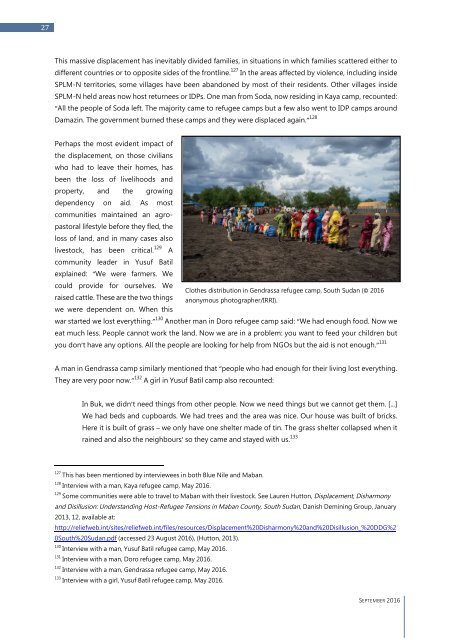A Crisis Normalised
2ctogG9
2ctogG9
You also want an ePaper? Increase the reach of your titles
YUMPU automatically turns print PDFs into web optimized ePapers that Google loves.
27 <br />
<br />
This massive displacement has inevitably divided families, in situations in which families scattered either to<br />
different countries or to opposite sides of the frontline. 127 In the areas affected by violence, including inside<br />
SPLM-N territories, some villages have been abandoned by most of their residents. Other villages inside<br />
SPLM-N held areas now host returnees or IDPs. One man from Soda, now residing in Kaya camp, recounted:<br />
“All the people of Soda left. The majority came to refugee camps but a few also went to IDP camps around<br />
Damazin. The government burned these camps and they were displaced again.” 128<br />
Perhaps the most evident impact of<br />
the displacement, on those civilians<br />
who had to leave their homes, has<br />
been the loss of livelihoods and<br />
property, and the growing<br />
dependency on aid. As most<br />
communities maintained an agropastoral<br />
lifestyle before they fled, the<br />
loss of land, and in many cases also<br />
livestock, has been critical. 129 A<br />
community leader in Yusuf Batil<br />
explained: “We were farmers. We<br />
could provide for ourselves. We<br />
Clothes distribution in Gendrassa refugee camp, South Sudan (© 2016<br />
raised cattle. These are the two things anonymous photographer/IRRI).<br />
we were dependent on. When this<br />
war started we lost everything.” 130 Another man in Doro refugee camp said: “We had enough food. Now we<br />
eat much less. People cannot work the land. Now we are in a problem: you want to feed your children but<br />
you don’t have any options. All the people are looking for help from NGOs but the aid is not enough.” 131<br />
A man in Gendrassa camp similarly mentioned that “people who had enough for their living lost everything.<br />
They are very poor now.” 132 A girl in Yusuf Batil camp also recounted:<br />
In Buk, we didn’t need things from other people. Now we need things but we cannot get them. […]<br />
We had beds and cupboards. We had trees and the area was nice. Our house was built of bricks.<br />
Here it is built of grass – we only have one shelter made of tin. The grass shelter collapsed when it<br />
rained and also the neighbours’ so they came and stayed with us. 133<br />
127<br />
This has been mentioned by interviewees in both Blue Nile and Maban.<br />
128<br />
Interview with a man, Kaya refugee camp, May 2016.<br />
129<br />
Some communities were able to travel to Maban with their livestock. See Lauren Hutton, Displacement, Disharmony<br />
and Disillusion: Understanding Host-Refugee Tensions in Maban County, South Sudan, Danish Demining Group, January<br />
2013, 12, available at:<br />
http://reliefweb.int/sites/reliefweb.int/files/resources/Displacement%20Disharmony%20and%20Disillusion_%20DDG%2<br />
0South%20Sudan.pdf (accessed 23 August 2016), (Hutton, 2013).<br />
130<br />
Interview with a man, Yusuf Batil refugee camp, May 2016.<br />
131<br />
Interview with a man, Doro refugee camp, May 2016.<br />
132<br />
Interview with a man, Gendrassa refugee camp, May 2016.<br />
133<br />
Interview with a girl, Yusuf Batil refugee camp, May 2016.<br />
SEPTEMBER 2016


